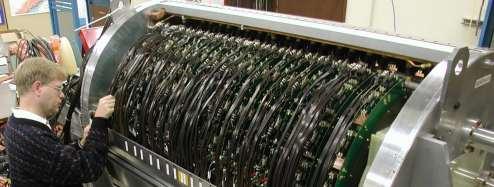
Elementary particles such as electrons are labeled as either "right-handed" or "left-handed". A surprising observation is that only left-handed particles seem to feel the weak nuclear force, whereas left- and right-handed particles feel the other fundamental forces equally. This difference, called parity violation, was predicted and observed in the 1950's, and led to a Nobel Prize. It is now a cornerstone of the modern Standard Model of subatomic physics. However, there are strong reasons to believe that this Standard Model is incomplete. "Left-right symmetric" theories explain parity violation by assuming that right-handed particles also respond to the weak force, but we would need to be in a much hotter world - with a temperature well above 1015 degrees - for this to be obvious. The idea is that in the early Universe, the weak force was left-right symmetric, but in the course of the evolution of the Universe, the right-handed interaction is somehow "frozen".
The TWIST Collaboration is testing these theories with high-precision measurements of the decay of the muon, a particle that appears identical to an electron in all regards except that it is heavier. The Collaboration has just reported the first improvement since 1966 in the measurement of the energy spectrum of positrons produced in muon decay. The result obtained so far agrees with the Standard Model predictions, and sets stringent new constraints to the left-right symmetric theories. The TWIST Collaboration will continue its effort to further scrutinize the Standard Model and its extensions, with yet higher precisions, as we seek to understand the origin of the left-right asymmetry in Nature.
The results are published in:
- J.R. Musser et al., Phys. Rev. Lett. 94, 101805 (2005)
- A. Gaponenko et al. Phys. Rev. D 71, 071101(R) (2005)
and they form the basis of two Ph.D. theses for Jim Musser and Andrei Gaponenko.
For more information, see the TWIST Experiment Website.
